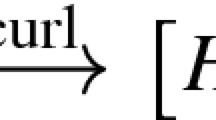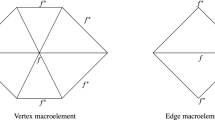Abstract
We construct 2D and 3D finite element de Rham sequences of arbitrary polynomial degrees with extra smoothness. Some of these elements have nodal degrees of freedom and can be considered as generalisations of scalar Hermite and Lagrange elements. Using the nodal values, the number of global degrees of freedom is reduced compared with the classical Nédélec and Brezzi–Douglas–Marini finite elements, and the basis functions are more canonical and easier to construct. Our finite elements for \({H}(\mathrm {div})\) with regularity \(r=2\) coincide with the nonstandard elements given by Stenberg (Numer Math 115(1):131–139, 2010). We show how regularity decreases in the finite element complexes, so that they branch into known complexes. The standard de Rham complexes of Whitney forms and their higher order version can be regarded as the family with the lowest regularity. The construction of the new families is motivated by finite element systems.






Similar content being viewed by others
References
Arnold, D.N.: Differential complexes and numerical stability. In: Proceedings of the International Congress of Mathematicians. Higher Education Press, Beijing, pp. 137–157 (2002)
Arnold, D.N., Awanou, G., Winther, R.: Finite elements for symmetric tensors in three dimensions. Math. Comput. 77(263), 1229–1251 (2008)
Arnold, D.N., Falk, R.S., Winther, R.: Differential complexes and stability of finite element methods I. The de Rham complex. In: Arnold, D.N., Bochev, P.B., Lehoucq, R.B., Nicolaides, R.A., Shashkov, M. (eds.) Compatible Spatial Discretizations, vol. 142, pp. 24–46. Springer, Berlin (2006)
Arnold, D.N., Falk, R.S., Winther, R.: Differential complexes and stability of finite element methods II: The elasticity complex. In: Compatible Spatial Discretizations, vol. 142, pp. 47–67. Springer, Berlin (2006)
Arnold, D.N., Falk, R.S., Winther, R.: Finite element exterior calculus, homological techniques, and applications. Acta Numer. 15, 1 (2006)
Arnold, D.N., Falk, R.S., Winther, R.: Mixed finite element methods for linear elasticity with weakly imposed symmetry. Math. Comput. 76(260), 1699–1723 (2007)
Arnold, D.N., Falk, R.S., Winther, R.: Geometric decompositions and local bases for spaces of finite element differential forms. Comput. Methods Appl. Mech. Eng. 198(21), 1660–1672 (2009)
Arnold, D.N., Logg, A.: Periodic table of the finite elements. SIAM News 47(9), 212 (2014)
Boffi, D., Brezzi, F., Fortin, M.: Mixed Finite Element Methods and Applications. Springer, Berlin (2013)
Bonito, A., Guermond, J.L.: Approximation of the eigenvalue problem for the time harmonic maxwell system by continuous lagrange finite elements. Math. Comput. 80(276), 1887–1910 (2011)
Boyse, W.E., Lynch, D.R., Paulsen, K.D., Minerbo, G.N.: Nodal-based finite-element modeling of Maxwell’s equations. IEEE Trans. Antennas Propag. 40(6), 642–651 (1992)
Brenner, S.C.: Forty years of the Crouzeix–Raviart element. Numer. Methods Partial Differ. Equ. 31(2), 367–396 (2015)
Brezzi, F., Douglas Jr., J., Marini, L.D.: Two families of mixed finite elements for second order elliptic problems. Numer. Math. 47(2), 217–235 (1985)
Chen, L., Hu, J., Huang, X.: Fast auxiliary space preconditioner for linear elasticity in mixed form. Math. Comput. (2017). https://doi.org/10.1090/mcom/3285
Christiansen, S.H., Hu, K.: Generalized finite element systems for smooth differential forms and Stokes problem (2016). arXiv preprint arXiv:1605.08657
Christiansen, S.H., Munthe-Kaas, H.Z., Owren, B.: Topics in structure-preserving discretization. Acta Numer. 20, 1–119 (2011)
Christiansen, S.H., Rapetti, F.: On high order finite element spaces of differential forms. Math. Comput. 85(298), 517–548 (2016)
Cockburn, B., Fu, G.: A systematic construction of finite element commuting exact sequences. SIAM J. Numer. Anal. 55(4), 1650–1688 (2017)
Costabel, M., Dauge, M.: Weighted regularization of Maxwell equations in polyhedral domains. Numer. Math. 93(2), 239–277 (2002)
Duan, H.Y., Jia, F., Lin, P., Tan, R.C.: The local \(L^{2}\) projected \(C^{0}\) finite element method for Maxwell problem. SIAM J. Numer. Anal. 47(2), 1274–1303 (2009)
Falk, R.S., Neilan, M.: Stokes complexes and the construction of stable finite elements with pointwise mass conservation. SIAM J. Numer. Anal. 51(2), 1308–1326 (2013)
Falk, R.S., Winther, R.: Local bounded cochain projections. Math. Comput. 83(290), 2631–2656 (2014)
Falk, R.S., Winther, R.: The bubble transform: a new tool for analysis of finite element methods. Found. Comput. Math. 16(1), 297–328 (2016)
Guzmán, J., Neilan, M.: Conforming and divergence-free Stokes elements in three dimensions. IMA J. Numer. Anal. 34(4), 1489–1508 (2013)
Guzmán, J., Neilan, M.: Conforming and divergence-free Stokes elements on general triangular meshes. Math. Comput. 83(285), 15–36 (2014)
Hiptmair, R.: Higher order Whitney forms. Progress Electromagn. Res. 32, 271–299 (2001)
Hiptmair, R.: Finite elements in computational electromagnetism. Acta Numer. 11, 237–339 (2002)
Hiptmair, R., Xu, J.: Nodal auxiliary space preconditioning in \( { \text{ H }}({ \text{ curl }})\) and \({ \text{ H }}(\rm { div})\) spaces. SIAM J. Numer. Anal. 45(6), 2483–2509 (2007). (electronic)
Hu, J.: Finite element approximations of symmetric tensors on simplicial grids in \(\mathbb{R}^{n}\): the higher order case. J. Comput. Math. 33, 283–296 (2015)
Hu, J., Zhang, S.: A family of conforming mixed finite elements for linear elasticity on triangular grids (2014). arXiv preprint arXiv:1406.7457
Hu, J., Zhang, S.: A family of symmetric mixed finite elements for linear elasticity on tetrahedral grids. Sci. China Math. 58(2), 297–307 (2015)
Hu, J., Zhang, S.: Finite element approximations of symmetric tensors on simplicial grids in \({\mathbb{R}}^{n}\): the lower order case. Math. Models Methods Appl. Sci. 26, 1649 (2016)
Karniadakis, G., Sherwin, S.: Spectral/hp Element Methods for Computational Fluid Dynamics. Oxford University Press, Oxford (2013)
Mardal, K.A., Tai, X.C., Winther, R.: A robust finite element method for Darcy–Stokes flow. SIAM J. Numer. Anal. 40(5), 1605–1631 (2002)
Nédélec, J.: Mixed finite elements in \(\mathbb{R}^{3}\). Numer. Math. 35, 315–341 (1980)
Nédélec, J.: A new family of mixed finite elements in \(\mathbb{R}^{3}\). Numer. Math. 50, 57–81 (1986)
Neilan, M.: Discrete and conforming smooth de Rham complexes in three dimensions. Math. Comput. 84(295), 2059–2081 (2015)
Raviart, P., Thomas, J.: A mixed finite element method for second order elliptic problems. Lect. Notes Math. 606, 292–315 (1977)
Saunders, D.J.: The Geometry of Jet Bundles, vol. 142. Cambridge University Press, Cambridge (1989)
Schöberl, J., Zaglmayr, S.: High order Nédélec elements with local complete sequence properties. COMPEL Int. J. Comput. Math. Electr. Electron. Eng. 24(2), 374–384 (2005)
Stenberg, R.: A nonstandard mixed finite element family. Numer. Math. 115(1), 131–139 (2010)
Tai, X.C., Winther, R.: A discrete de Rham complex with enhanced smoothness. Calcolo 43(4), 287–306 (2006)
Wang, M., Xu, J.: The Morley element for fourth order elliptic equations in any dimensions. Numer. Math. 103(1), 155–169 (2006)
Zaglmayr, S.: High order finite element methods for electromagnetic field computation. Ph.D. thesis, Johannes Kepler University (2006)
Acknowledgements
The authors are grateful to Dr. Rui Ma, Mr. Espen Sande, Prof. Ragnar Winther and Prof. Jinchao Xu for helpful communications and to the anonymous referees for valuable suggestions.
Author information
Authors and Affiliations
Corresponding author
Additional information
Snorre H. Christiansen is supported by the European Research Council through the FP7-IDEAS-ERC Starting Grant scheme, Project 278011 STUCCOFIELDS. Jun Hu is supported by the NSFC (Projects 11625101, 91430213, 11421101). Kaibo Hu is supported by the European Research Council under the European Union’s Seventh Framework Programme (FP7/2007-2013)/ERC Grant Agreement 339643.
Rights and permissions
About this article
Cite this article
Christiansen, S.H., Hu, J. & Hu, K. Nodal finite element de Rham complexes. Numer. Math. 139, 411–446 (2018). https://doi.org/10.1007/s00211-017-0939-x
Received:
Revised:
Published:
Issue Date:
DOI: https://doi.org/10.1007/s00211-017-0939-x





